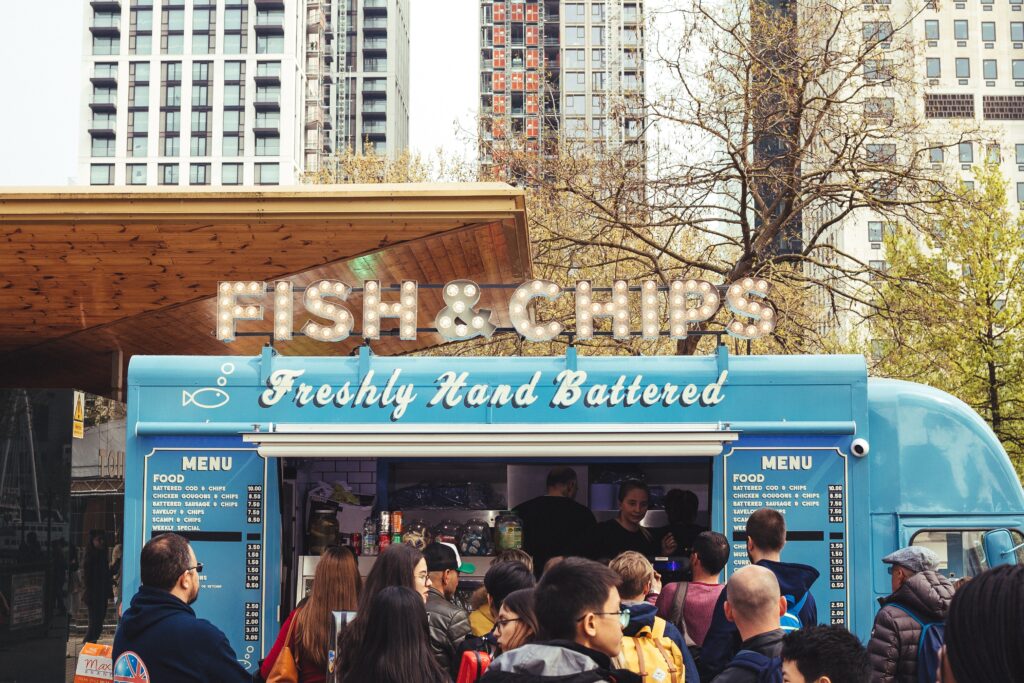
Twenty years ago food truck parks were not easily spotted. Today, walk five feet from any downtown hot spot and you’ll find a food truck (maybe several) luring customers in with the aroma of sizzling street tacos, burgers, German Brats, and any delicious food you can think of. Whether it’s college areas of town, art fairs, or outdoor concerts, things would not be the same without the food truck.
Let’s back up. While the food truck revolution seems like a recent phenomenon, the origins of mobile food vendors span all the way back to early push carts carrying fruit, sausages, and more.
So how did the wonderful food truck revolution evolve? Let’s dive into some history.
From Food Carts to Chuck Wagons to Much More
The history of the food truck begins in early American history. As soon as people could grow food and sell it, the idea was a logical conclusion. Going back to the early colonies, food carts were common. It was a way for farmers to cash in on their crops. The industry became regulated, however, around 1691. In the 1800s, as passenger trains became more common, dining cars began feeding passengers and the Chuck Wagon was invented by a man named Charles Goodnight to catch hungry cattlemen and cowboys going through the Wild West.
Interestingly enough, college students have played a big role in the food truck revolution. The “dog wagons” begin on college campuses, with vendors selling sausages outside of places like Princeton, Yale, Harvard, and Cornell. In the 1980s, college campuses were popular spots to park sandwich trucks or what were called “fat sandwiches.” These beloved mobile food spots were affectionately called grease trucks.
And then enter the WeinerMobile! The history of this industry would not be complete without a word or two about Oscar Meyer’s famous Weiner Mobile. This amazing hot dog-shaped vehicle turned heads.
The World’s First Taco Truck
According to some histories, the first taco truck emerged in a park in East L.A. A local man named Raul Martinez converted his old ice cream truck into a truck that specialized in serving Mexican-style street tacos. These tacos were geared mostly to the working class, workers-on-the-go, and miners. Martinez parked his truck outside of a Los Angeles bar. After six months of running his little taco truck, Martinez was able to open up a full restaurant. This restaurant would be called King Taco, which would become a multi-million dollar chain.
The 21st Century and the New Food Truck Revolution
As the 2000s rolled around grease trucks and taco trucks became much more ubiquitous. The food truck park garnered more attention in the early 2000s, as hip and trendy cities like Austin and Portland. In these young college towns, food truck parks have become gathering places for bearded hipster types to get some grub in between classes. The food truck park, however, has now become much more than that. For many neighborhoods around the country, it has become a place where neighborhoods suddenly offer dining options, where the food trucks revitalize parts of town and fill them with people.
And since the food truck is now a highly competitive market, the vehicle wrap, and design that lures newcomers into your mobile kitchen has become that much more important. The food truck design is your brand.
It tells passersby what you’re all about. And today, people have gotten creative about the kind of design they drive around with.
Tips for Decorating Your Food Truck With an Awesome Vehicle Wrap
So in this dog-eat-dog world of food truck competition, you have to know that the visual representation of your vehicle becomes immediately associated with your brand and your food. So, for your vehicle wrap ideas:
- Go all out. In other words, don’t simply handwrite the name of your food enterprise on the side. Think of a concept. Evoke an attitude. Design something with purpose
- Keep it colorful. Colors get people’s attention. That doesn’t mean that color is the only way to go. If you want to keep it black and white, that’s ok, as long as it goes with your restaurant aesthetic. The main point is to be deliberate with your use of colors.
- Think about it from all angles. Remember your food truck has to call someone’s attention from far away, from close up, from the front, the back, and the side.
- Look at the competition and then stand out. If you know where your food truck will be parking on the regular, why not drive around the area or even around the city. This can provide you with ideas about what the competition is doing and how you can stand apart.
Stand Out and Call New Customers Forward With Quality Vinyl Truck and Vehicle Wraps
Go big or go home. That’s the motto for food truck vendors today. The competition is fierce and in order to stand out, you have to go big. You have to use creative design, eye-popping color, unique fonts, and much more. Whether you are a recently established business, local contractor, or food truck vendor, paint your name with style.
Want to learn more? Call us at Wrap Genius today.